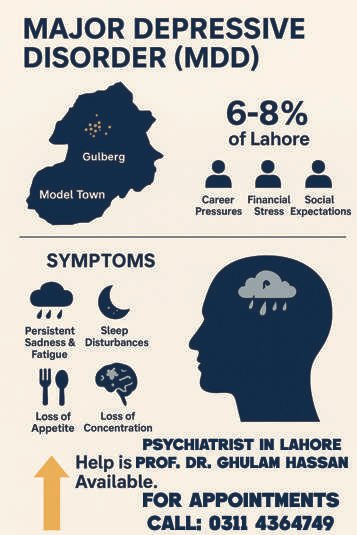The city of Lahore faces a growing mental health burden, with psychiatric disorders affecting people across all age groups and backgrounds. The most common conditions include Major Depressive Disorder (MDD), Generalized Anxiety Disorder (GAD), Bipolar Disorder, Schizophrenia, and Post-Traumatic Stress Disorder (PTSD). Cultural beliefs, societal pressures, and environmental stressors contribute to their prevalence, while limited awareness and stigma make treatment difficult.
Below is a structured overview of these psychiatric disorders in Lahore, along with area-specific solutions by psychologists.
Depression in Lahore (Major Depressive Disorder – MDD)
Prevalence
Around 6–8% of Lahore’s population experiences Major Depressive Disorder. Urban centers like Gulberg, Model Town, and DHA report higher cases due to career pressures, financial stress, and social expectations.

Symptoms
- Persistent sadness and fatigue
- Sleep disturbances
- Loss of appetite and concentration
- Suicidal thoughts
Area-Wise Solutions
- DHA & Gulberg: Workplace stress management programs and access to private psychiatric clinics.
- Township & Faisal Town: Affordable counseling services in community health centers.
- Rural outskirts of Lahore: Telepsychiatry sessions for those unable to travel.
Anxiety in Lahore (GAD & Social Anxiety Disorder)
Prevalence
Anxiety disorders, especially GAD, affect around 5% of Lahore’s population. Students in Johar Town and Garden Town face educational pressures, while young professionals in Shadman and Gulberg struggle with performance anxiety.
Symptoms
- Persistent worry
- Restlessness
- Difficulty concentrating
- Fear of social situations
Area-Wise Solutions
- Johar Town & Garden Town: Student-focused counseling and stress management workshops.
- Shadman & Gulberg: Cognitive Behavioral Therapy (CBT) clinics for workplace anxiety.
- Model Town: Support groups for parents and professionals dealing with chronic anxiety.
Bipolar Disorder in Lahore
Prevalence
Bipolar Disorder affects 1–2% of Lahore’s population, with many cases going undiagnosed.
Symptoms
- Mania: High energy, irritability, impulsive behavior.
- Depression: Fatigue, hopelessness, social withdrawal.
Area-Wise Solutions
- Model Town & DHA: Specialized psychiatric centers for accurate diagnosis and long-term treatment.
- Township & WAPDA Town: Psychoeducation programs for families to recognize symptoms early.
- Gulberg: Access to private hospitals offering mood-stabilizing treatments.
Schizophrenia in Lahore
Prevalence
About 1% of Lahore’s population experiences schizophrenia. Misconceptions often lead families to seek spiritual healers instead of psychiatric professionals.
Symptoms
- Hallucinations (hearing voices)
- Delusions (false beliefs)
- Disorganized thinking and speech
Area-Wise Solutions
- Samanabad & Muslim Town: Awareness drives to counter myths linking schizophrenia to supernatural causes.
- Bahria Town & EME Society: Access to modern rehabilitation centers.
- Inner Lahore (Androon Shehr): Mobile psychiatric clinics for underserved communities.
PTSD in Lahore
Prevalence
PTSD is common among first responders, law enforcement officers, and victims of violence or accidents. Common incidents and road accidents have increased PTSD prevalence in Shahdara, Ravi Road, and Walled City areas.
Symptoms
- Nightmares and flashbacks
- Severe anxiety
- Emotional detachment
- Avoidance of trauma-related situations
Area-Wise Solutions
- Shahdara & Ravi Road: Trauma counseling centers for accident victims.
- Garden Town & Gulberg: Therapy programs for law enforcement and rescue workers.
- Bahria Town & DHA: Corporate initiatives supporting trauma recovery.
Addressing Psychiatric Disorders in Lahore
The mental health landscape in Lahore reveals an urgent need for psychiatric awareness, early diagnosis, and accessible treatment. While stigma continues to block timely care, area-specific strategies can significantly improve outcomes.
Actionable Steps for Lahore’s Mental Health Improvement:
- School & University Programs – Integrate mental health education across Johar Town, Garden Town, and DHA schools.
- Affordable Care Expansion – Strengthen public psychiatric facilities in Township, Faisal Town, and Shahdara.
- Destigmatization Campaigns – Launch city-wide awareness drives to normalize seeking psychiatric help.
- Telepsychiatry & Online Counseling – Connect patients from underserved areas like Androon Lahore with city psychiatrists.
- Community Support Groups – Encourage peer-led mental health groups in Shadman, Gulberg, and Model Town.
